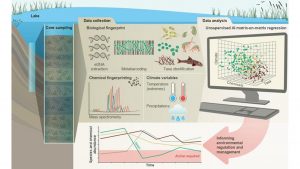Using AI analysis, scientists have created a ‘biodiversity time machine’ to detect a century of pollution levels, extreme weather events, and increasing temperatures.
AI analysis has enabled the team to shed light on a century of environmental change in a freshwater lake – including warming temperatures and pollution, leading to the potentially irreversible loss of biodiversity.
The new approach could help regulators to protect the planet’s existing biodiversity levels or even improve them.
The study, ‘100 years of anthropogenic impact causes changes in freshwater functional biodiversity,’ is published in the journal eLife.
How AI analysis creates a biodiversity time machine
Researchers from the University of Birmingham, in collaboration with Goethe University in Frankfurt, used sediment from the bottom of a lake in Denmark to reconstruct a 100-year-old library of biodiversity, chemical pollution, and climate change levels.
This lake has a history of well-documented shifts in water quality, making it a perfect natural experiment for testing the biodiversity time machine.
The AI analysis revealed that the sediment holds a continuous record of biological and environmental signals that have changed over time – from (semi)pristine environments at the start of the Industrial Revolution to the present day.
The team used environmental DNA – genetic material left behind by plants, animals, and bacteria – to build a picture of the entire freshwater community.
Assisted by the AI analysis, they analysed the information, in conjunction with climate and pollution data, to identify what could explain the historic loss of species that lived in the lake.
Luisa Orsini, Professor of Evolutionary Systems Biology and Environmental Omics at the University of Birmingham and the study’s lead researcher, explained: “We took a sediment core from the bottom of the lake and used biological data within that sediment like a time machine to build a detailed picture of biodiversity over the last century at yearly resolution.
“By analysing biological data with climate change data and pollution levels, we can identify the factors having the biggest impact on biodiversity.”
Which pollutants have caused the most damage to biodiversity levels?
The biodiversity time machine showed that pollutants such as insecticides and fungicides, alongside increases in minimum temperature (a 1.2-1.5-degree increase), caused the most damage to biodiversity levels.

However, the AI analysis showed that the DNA present in the sediment over the last 20 years had begun to recover. Water quality improved as agricultural land use declined in the area surrounding the lake.
Yet, whereas the overall biodiversity increased, the communities were not the same as in the (semi)pristine phase. This is concerning as different species can deliver different ecosystem services, and therefore their inability to return to a particular site can prevent the reinstatement of specific services.
Niamh Eastwood, lead author and PhD student at the University of Birmingham, said: “The biodiversity loss caused by this pollution and the warming water temperature is potentially irreversible.
“The species found in the lake 100 years ago that have been lost will not all be able to return. This research shows that if we fail to protect biodiversity, much of it could be lost forever.”
What’s next?
Next, the researchers will expand their AI analysis from a single lake to lakes in England and Wales.
This new study will help them understand how replicable the patterns they observed are and, therefore, how they can generalise their findings on pollution and climate change on lake biodiversity.
“We have demonstrated the value of AI-based approaches for understanding historic drivers of biodiversity loss. As new data becomes available, more sophisticated AI models can be used to further improve our predictions of the causes of biodiversity loss,” concluded Dr Jiarui Zhou, co-lead author and Assistant Professor in Environmental Bioinformatics at the University of Birmingham.





